The McMinnville UFO photos are 70 years old
In May 1950, two down-to-Earth Oregon farmers took a couple of photos that were out-of-this world.
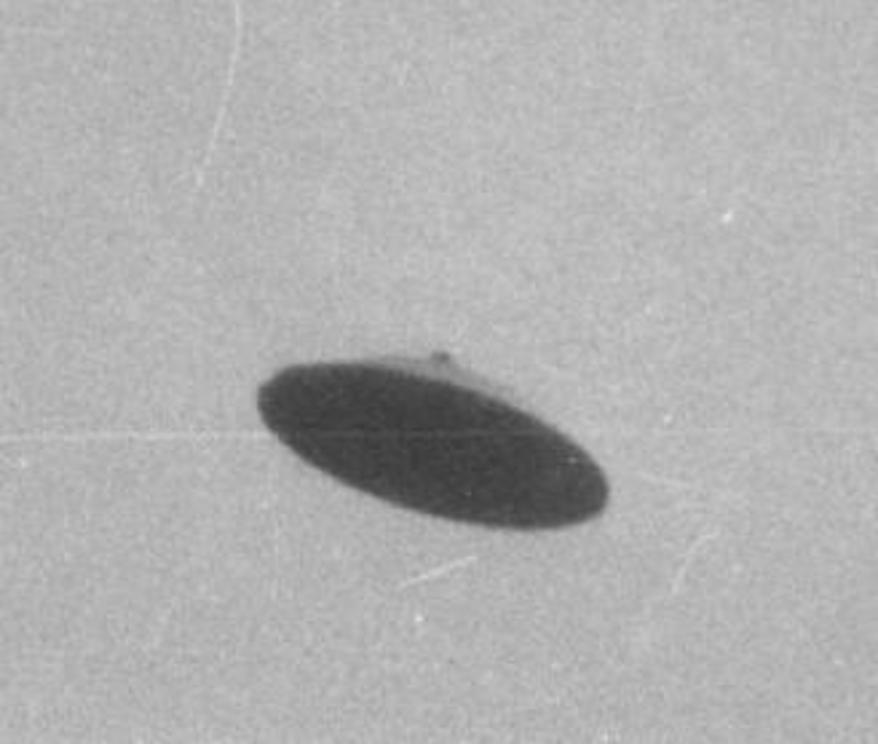

After becoming a public sensation in June 1947 with the famous Kenneth Arnold sighting, flying saucers were the talk of America. There were numerous reports being made, many witnesses, and unconfirmed photos. However, there were no clearly unstaged photos of actual craft that made the grade with their uncontested quality.
In 1950, When the Nation Wanted Proof, It Flew Over a Farm in Oregon
On May 11, 1950, Paul and Evelyn Trent saw history gliding over their farm in the form of a single 100-foot flying saucer, and snapped two famous pictures of it from different angles, thirty seconds apart. The story blew wide open a month and a half later.
On June 26, 1950, Life magazine printed what everyone then agreed were two of the best flying saucer photos ever taken. They were not images of blurry lights in the sky or birds or weather balloons. They were real, structural, and metallic. The only valid question was whether they were authentic mysteries or just hoaxes.
Flying Saucer Moment of Zen
Do these photos look like the side mirror to a 1947 pick-up truck suspended by a thread, or a garbage can lid tossed into the air, two theories floated by skeptics?
The best place to start in an article about photo analysis of something potentially extraordinary is to take a moment to look at the full size scan of the photos. Take a good look at them on the best screen you have. The full story’s on the other side…
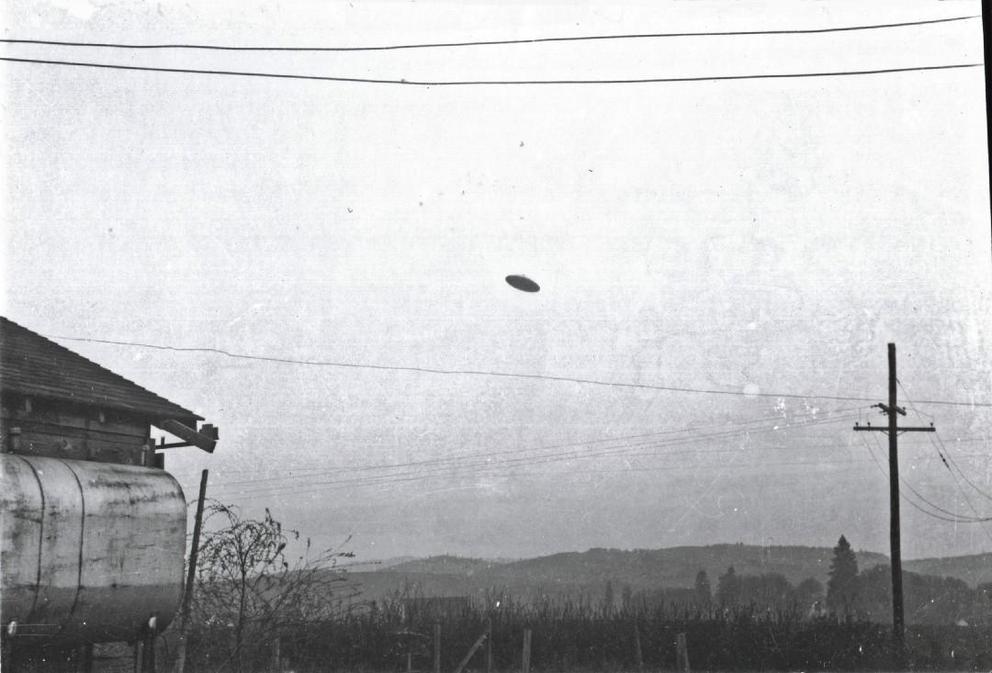
The Trent Farm | Sheridan, Oregon | May 11, 1950 | Public Domain

In the intervening years, these two photos the Trents exposed in half-a-minute flurry have been studied by the Air Force, the CIA’s Condon Report, and multiple researchers. They’ve appeared in articles thousands of times. The Trents, by the way, never made any money for any of those uses.
People are still split on the real-versus-hoax divide, but the edge over time goes to acceptance that they were taken unstaged.
They Weren’t Looking for a Flying Saucer
Located just off the Salmon River Highway, Paul and Evelyn Trent worked their small farm in Sheridan, Oregon in the years just after the Second World War. It was a timber and farming community just a short drive from Oregon’s fertile Willamette Valley. It was a hard life, but they were hard-working people.
Sheridan is about ten miles away from the Yamhill County seat of McMinnville that’s always listed as the location where the photographs were taken. These days, McMinnville throws an annual UFO Festival with a parade to keep that fiction alive.
To put the timeframe into perspective: WWII ends in 1945, Kenneth Arnold sees flying saucers up in Washington State in June 1947, a few weeks later there’s the Roswell, New Mexico crash, and three years later, the Trents take their pictures. Things were hopping, ufologically speaking.


Paul and Evelyn Trent | Life, 1950
SIDEBAR: Before I was born, my parents moved to the Oregon coast the same year these photos were taken, and settled about 40 miles from this location. For Oregonians, this was a local story.
At the End of a Long Day
Even though it was overcast, there was still decent light that evening — May 11, 1950 — when Evelyn left the house around 7:30 p.m. to do her evening chores. They had chickens and rabbits that needed to be fed.
Evelyn was walking back to the house. Only three million TV sets existed in America back then, and they didn’t have one of them. They kept farmer’s hours — early to bed, early to rise.
She saw a two-toned disc-shaped craft silently gliding over their field. She knew instantly that this was not something she had seen before.
“It was bronze on the top and silver on the bottom. I would say right around the size of a big parachute. Maybe even a little bigger.”
Evelyn ran back into the house to get Paul to come out and look at it. He saw it, too, noting that it made no noise and issued no smoke or vapor around it.
Her husband grabbed his Universal Roamer camera from inside the house. The Roamer used 60mm roll film (i.e. Kodak 120 or 620 stock) and to advance the film to shoot another picture involved a few seconds turning a tiny chrome knob a few full revolutions. Paul was proud of this camera nonetheless, even if the film cost a fortune. He bolted out, hoping that the object was still there.
By the time Paul got back outside with his Universal Roamer, the object started moving away. Acting quickly, Paul snapped off these two famous shots in about thirty seconds. As the object flew away from the Trent farm, the photos framed it on the left by the Trent’s garage and on the right and bottom by a range of mountains. The second exposure turned out to be critical because Paul changed his position to get it, running several yards to keep it in sight, and this later allowed for a detailed photographic analysis.
What They Didn’t Do Next
Something that bolsters the Trent’s account and their implied honesty is what they didn’t do next. They didn’t go to the newspapers. They didn’t even develop the film right away. This was so unusual that when the story did break a month and a half later in Life, the magazine began its article this way.
Farmer Paul Trent of McMinnville, Oregon is a frugal man. Last winter he bought a roll of film for his camera and shot a snow scene. One month later he took a picture of a weeping willow in his front yard. Last May 11 he saw a flying saucer above his house and made two pictures of that. On Mother’s Day he used up the last three negatives on his roll at a family picnic. Then he got the film printed up.
It seems just crazy. If it happened today, those photos would be on Instagram seconds after taking them. Why wait?
Three reasons: film was expensive and Paul was tight with a dollar as he had to be. Plus, the Trents weren’t looking for publicity anyway. The third and most disquieting reason was that they were worried that they’d seen some sort of government experiment, possibly a secret one. If they told people about the pictures, they could get in trouble.
Eventually, the roll was developed, of course, and the Trents showed the photos to a few friends and allowed them to be posted at their church. Frank Wortman was so taken by them that he told the McMinnville Telephone-Register about them. The first time they were published was June 8, 1950 on the front page.

McMinnville Telephone-Register | June 8, 1950
No one could dismiss these photos as lights in the sky or weather balloons. They were clearly a craft of some kind. The only way they weren’t what they said they were would be if the Trents had plotted the whole thing. Their behavior after taking them, and their reputations as honest, decent folk, made that seem like a long-shot.
The next two days saw newspapers in Portland, Oregon and Los Angeles, California run their own articles. That was followed by the story picking up global momentum through the International News Service (INS) and the Associated Press (AP).
If you want to appreciate how the public felt about this topic, wrap your head around this. For a mere dime, anyone could order a copy of the Telephone-Register. In all, the paper went to press three times, and over 10,000 reprints of the paper were shipped out during the three weeks following its initial publication.
It was a hot story which made what happened next inevitable.
Life magazine, being the nation’s largest circulation magazine, reprinted the photos in its June 26, 1950 issue. People couldn’t get enough of that issue either.
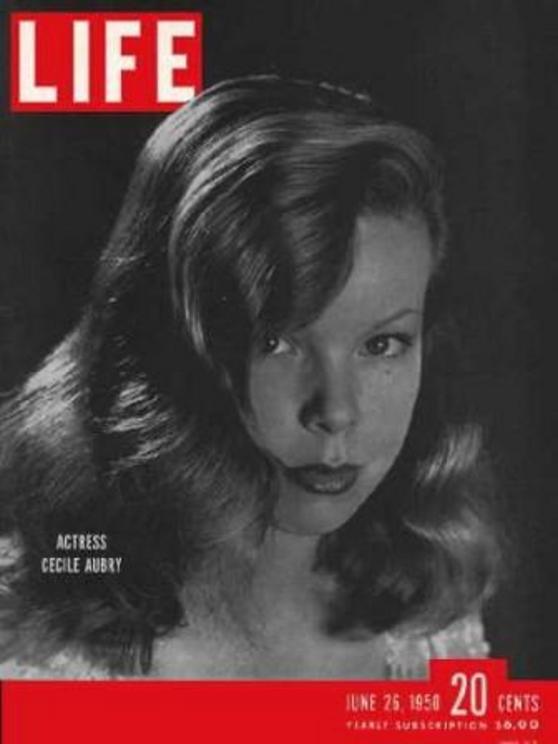

Life, June 26, 1950
As their brush with history played itself out, the unassuming Trents ended up in New York taping “We the People.” They didn’t play the circuit, though. They did the show and went back home to the farm.
As the story spread, a few articles dubbed McMinnville, “Saucerville.” While that brings a smile, the Trents were also getting a less-welcome form of attention.
In the backwash of this publicity, both the FBI and the Air Force sent investigators to the Trent house where they took their own photos, searched the premises and questioned the family. All of which is odd behavior if you’re positive that UFOs don’t exist.
TV personality and radio host Frank Edwards at the Mutual Broadcasting Network claimed to have taken enlargements of the photos to the Pentagon. He had to self-brag the accomplishment.
“I was told they were the best civilian photographs of an Unidentified Flying Object that the Air Force had ever seen.”
Although the Trents seemed to enjoy their moment in the national spotlight, they made no money from it, and quickly tired of the attention. Toward the end of their lives, they stated they wished they had never taken them.
No One is Positive about the Negatives
The story of what happened to the negatives has its own mystery to it. I’ve read many articles about these photos and they are not consistent about the specifics. In addition, two researchers who studied them have each told me their best information.
This is my take, and I’ll update this section, if/when other voices are heard from.
For starters, in 1950, people were less interested in photographic instant gratification. Even after the Trents gave their film to the local drugstore, they had to wait an entire week for the roll to be developed! After the Trents got the pictures for themselves, the man who had them next was Bill Powell, the reporter for the McMinnville newspaper. He blew them up “every which way” and couldn’t figure out how they could have been faked and, if that was a theory, how the honest, decent and relatively simple people he’d interviewed for hours could have conspired to do it.
The Trents said that when they went to New York to tape the “We the People” program that the show’s producers instructed them to bring the negatives along to New York. According to the Trents, the show “borrowed” them, and the Trents never saw the negatives again. When they asked about them, they were told they were “misplaced.”
Where they went after that is to the UPI press offices where they remained “lost” for 17 years.
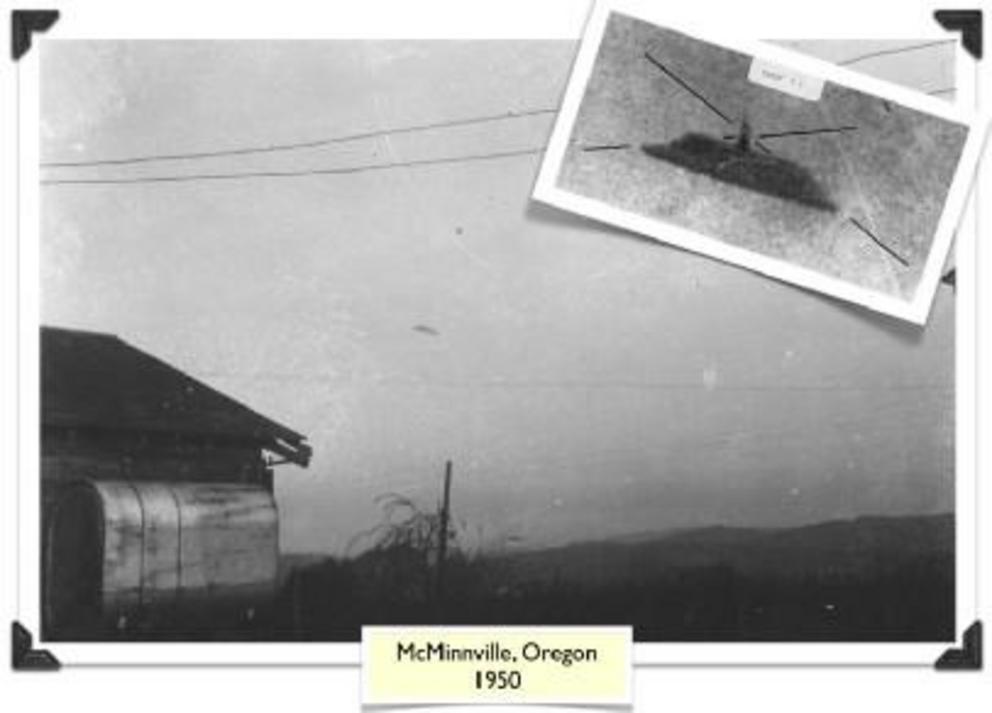

Trent Photos | Actually Sheridan, Oregon | Graphics by Stellar Productions
A different version of this story comes from UFO historian Richard Dolan. Writing in his exhaustive UFOs and the National Security State, Dolan states the Trents received visits from both the FBI and the Air Force after the local news article. So, too, did reporter Powell, who presumably at the time had possession of the negatives. An Air Force agent demanded those negatives and never returned them. Powell repeatedly requested them back, but had no luck.
Confused? Me, too. Either the Trents gave them to a national TV show that gave them to UPI, or Powell gave them to government officials. Sounds mutually exclusive, particularly given what happened next.
What can be said for certain, however, is that the negatives went missing in 1950.
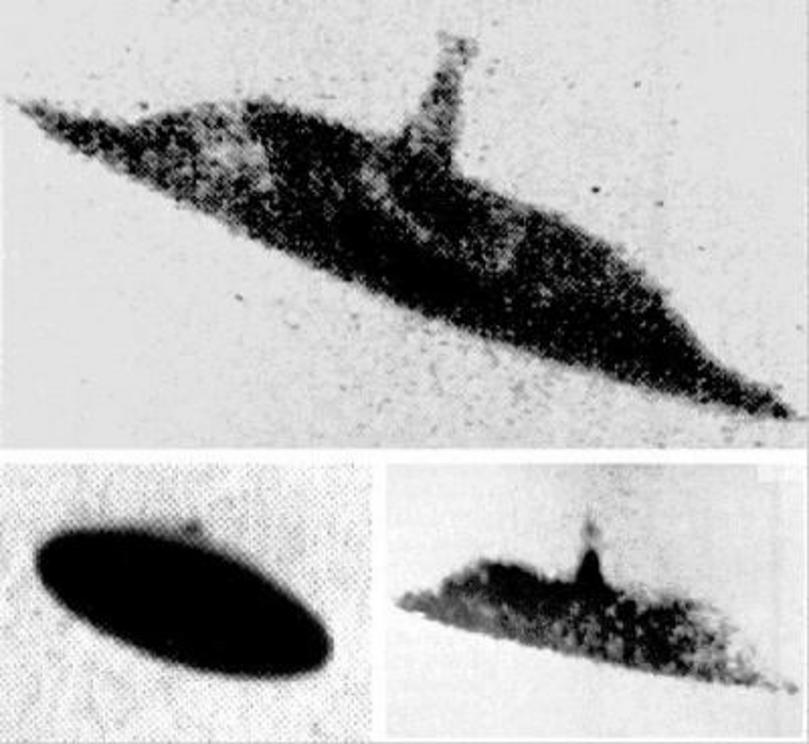
Rouen, France (top), McMinnville, U.S. (bottom)
As an interesting sidebar, a French military pilot near Rouen, France took a photo of a UFO almost four years after the Trent photos on March 5, 1964. It’s a virtual match to the one that shows the “conning tower” type of configuration.
The story picks up again in the late ’60s. The US Air Force, in conjunction with the University of Colorado, commissioned an investigation into the UFO phenomenon (aka the “Condon Committee”). After being lost for 17 years, the negatives apparently turned up in a UPI file, and were handed over to the Condon Committee for analysis.
The Condon Conclusion
Armed with the actual negatives, astronomer William K. Hartmann was put in charge of the committee’s section on photographic evidence. He constructed the disqualifiers that a winning photo would have to get past: misidentifications, outright lies, bad image quality, and clear images that lacked sufficient data for good analysis. Only two cases made it past that barrier and the Trent’s case was one of them. After years of exhaustive scientific inquiry, in 1968, the Condon Report said of the photos:
— This is one of the few UFO cases in which all factors investigated, geometric, psychological, and physical appear to be consistent with the assertion that an extraordinary flying object, silvery, metallic, disc-shaped, tens of meters in diameter, and evidently artificial, flew within sight of two witnesses. —
Hartmann calculated by photometry that the craft was just over a kilometer away from the camera in the first shot. He also concluded that it was about 30 meters, or 100 feet, in diameter.
The Condon Report’s conclusion not only re-established the Trent case at the forefront of UFO lore, it sparked a rash of theories by skeptics who attempted to discredit the photos. As these things go, the debunkery spawned more investigation,
Following the conclusion of the Condon report, reports indicate the negatives were returned to UPI, and in 1970 they were sent back to the News-Register (formerly the Telephone Register) in McMinnville. When they arrived back at the paper, now twenty years since coming from the Trent’s camera, the negatives had apparently been tampered with considerably. Someone had cropped the negatives, trimming down the edges and reducing their overall size so that parts of the original image were missing.
Why would someone crop the negatives?
There are only two good reasons. The first would be for clarity. If you look at the images in Life, they have clearly been cropped to remove the nearby telephone lines. It makes for a more dramatic photo. It also creates a second reason — that they were cropped so people wouldn’t see the telephone lines and think that the photos were hubcaps or a gas tank lid suspended from a wire or a string.
Other Voices
The Condon Report, despite being an overall negative view of UFO reality, seemed to strongly support the reality of the photos, as analyzed by Hartmann. That’s where things stood for about six years.
That’s when skeptics like Robert Schaeffer and the late Phillip Klass decided to weigh in. They never could dismiss the clarity of the photos or what they imply, if authentic, so they focused on the hoax aspect. They even had a favorite suspect, the side-view mirror on a pick-up truck that Paul drove, suspended from one of those telephone wires. In 1974, they concluded that there were possible inconsistencies in the verbal evidence and how it was supported (or not) by the photographic evidence. Most specifically, they believe the photos were taken in the morning, not in the evening as claimed. My view? That is a big stretch, and it’s dealt with at length in the extremely comprehensive report of the next person to take a crack at the case.
In 1975–1976, optical physicist Dr. Bruce Maccabee borrowed the negatives from the Trents. Maccabee made his bones in optical data processing at the US Naval Surface Warfare Center, so he can be considered an expert opinion. He put the photos to every test he knew, looking to expose fraud, if he found it. He not only interviewed people, he looked into what a faked photo of such a UFO hanging from a string would look like, to check for similarities. Maccabee wrote a voluminous report and concluded, based on factors like shadows, sunlight, etc., that they were not hoaxed but the real deal.
“The Trent photo case is a classic because of its ‘age’ and also because the object is depicted so clearly that it is either a model (hoax) or it is an ‘extraordinary flying object.’ The case is also a perfect illustration of the fact that, when trying to prove an extraordinary sighting is factual, it is not sufficient to have clear photographs and several witnesses. Ever since the photos were published, explanations have been offered by people who never spoke to the Trents. These explanations have often been based on imperfect or incomplete investigations of the case. Unfortunately, scientists were not interested in the case at the time that the photos were published, so the Trents were not interviewed in depth, the negatives were not carefully analyzed, and valuable datas was lost forever.”
Maccabee concluded that the photographs showed a “real, physical” object in the sky above the Trent farm. Maccabee argued that the brightness of the object’s underside suggested it was at some distance from the camera, not a smaller object close to it. He believed the Trent’s story and he believed their photographic evidence. He has written an exhaustive report. If you want to do a deep dive into this subject, do read it here.
For his part, Maccabee now believes the photos are in the possession of the Trent family, something I’m looking into.
Postscript
To this day, the photos have taken on a life of their own, seen by many as the most significant images in UFO history, and grounding one of most reliable cases ever. There’s no doubt that as we develop technology to analyze the “deep fake” capabilities that computers have given us, there will be new opportunities to take a fresh look at these classics. Questions will again be raised but the through-line is that their authenticity remains the majority opinion over a sustained seventy year existence.
Over the years, the Trents continued to grant interviews about the photos. Small details shifted with time, as happens with any fading memory, but the account they told was overall consistent and it held on to its credibility over the years.
The Trents never tried to make money from the photos, or assert the right to license them. In 1998, Paul spoke about this. “I took the pictures, but I don’t want them. First thing I know is we’d have too much trouble.”
Evelyn agreed, “Like I said, I would never take another picture. Just too much publicity.”
Fact or Faked?
We are left where many UFO stories leave us — in frustration. Researchers investigate, believers promote, and skeptics doubt. This leaves so many good cases in the gray basket of credibility which renders them useless to people new to the topic. Some say yes, some say no, so the answer is maybe, maybe not.
I hate that being the historical resting place for these photos.
I’ve spent hours looking at them. I’ve read books that mention them, and the reports and documents investigating them. I’ve talked to informed people. I have a friend who took care of the Trents when they were in a nursing home at the end of their lives. She describes Paul and Evelyn as decent people who could not tell a lie.
At the end of the day, I believe that the Trents saw something extraordinary that spring night in 1950. They did the best they could with the equipment and experience they had to record it accurately. Then, when the images became public, they spoke as truthfully as they could about what they saw.
The photos are real.


Trent Photos | Moment of Zen | Public Domain
